Vol 4 No. 5 TROPIC LIGHTNING NEWS February 3, 1969
Index
Third
Brigade Records Another Bountiful Year
DAU
TIENG
- The 3d Brigade has drawn the curtain on a year in which the Tropic Lightning
infantrymen killed more than 4,200 enemy.
In 12 months of fighting
which ranged from the streets of Saigon to the jungles of War Zone C, the
brigade captured more than 426,000 lbs of rice and countless weapons and
ammunition.
The year was highlighted by
counterpunches at Soui Cut, where more than 350 enemy died in a single night;
near Saigon in the enemy’s abortive Tet offensive; around Trang Bang and Tay
Ninh City during the enemy thrusts in May and August, and in the area near Dau
Tieng base camp during the closing months of the year.
As the year began, the
brigade’s forces were positioned in Fire Support Base Burt, on the Soui Cut, a
small stream 60 miles northwest of Saigon.
In the second largest single
day action of the war, forces of the 2d Battalion (Mech), 22d Infantry and 3d
Battalion, 22nd Infantry dealt death on enemy human waves hurling
themselves out of the jungle on the night following New Year’s Day.
Aided by guns of the 2d
Battalion, 77th Artillery, helicopter gunships and tactical air strikes the
infantrymen killed 382 enemy.
During the days following
Tet, the brigade’s forces were split between the areas around Dau Tieng and
Saigon. While the 2d Battalion (Mechanized), 22d Infantry Triple Deuce ranged
Dau Tieng to Trang Bang in road sweeps and combat operations, the brigade’s
other two battalions fought in areas between Cu Chi and Saigon.
In fierce fighting less than
10 miles from Saigon and in Cholon, infantrymen of the 2d Battalion, 12th
Infantry and 3d Battalion, 22d Infantry, dealt with enemy in house to house
fighting and in battles across rice paddies.
In April, Regulars of the 3d of
the 22d, backed by the Triple Deuce, killed 137 enemy in a night battle near the
edge of war Zone C.
As the enemy tried yet
another offensive in May, Tropic Lightning organized Task Force Daems, bringing
numerous units of the Division under operational control of the 3d Brigade.
In 13 days the Task force
accounted for more than 600 enemy in sweeps ranging from Hoc Mon and the Saigon
area toward Tay Ninh City. In all,
the force accounted for more than 800 enemy killed.
At the conclusion of the
summer operations the brigade held the enviable record of not allowing a single
enemy rocket or mortar round to be fired from its area of responsibility.
Earlier the area had been notorious as part of the enemy rocket belt.
With its return to Dau Tieng
near the edge of War Zone C, 45 miles northwest of Saigon, the brigade has
concentrated on thrusts into the Boi Loi Woods and Trapezoid areas, as well as
longtime enemy strongholds in the Mushroom, Crescent and Onion.
Operations by the 1st
Battalion, 27th Infantry Wolfhounds in the Trapezoid and in deserted rubber
plantations resulted in the uncovering of many substantial caches.
One of the largest finds included a hospital and more than 1,000 lbs of
medical supplies as well as a grenade factory.
Meanwhile the Triple Deuce
killed 73 attackers who attempted to ambush a convoy in the Ben Cui Rubber
Plantation.
A major step along the way
to pacification was the reopening of route 14, which serves as the main artery
of transportation on the east side of the Saigon River south of Dau Tieng.
Warriors,
Air Strikes Doom 16 Viet Cong
By SP4 Charles Haughey
CU
CHI -
Second Brigade soldiers of the 2d Battalion, 12th Infantry, killed 16 Viet Cong
in two days of fierce fighting nine miles north of Cu Chi.
The First platoon of the
battalion’s Charlie Company spotted oversized rice shocks near a distant weed
line just outside the small jungle village of Bo Hea.
“The shocks were fat and
looked as though they were hiding something,” said platoon leader First
Lieutenant Louis M Gietka from Clarks Summit, Pa.
“It seemed too obvious,” he continued, “So I directed my grenadiers
to drop M79 rounds into the area.”
Just as the round landed to
expose what appeared to be a mortar tube, the Fire Brigade soldiers began
receiving .51 caliber fire from their right flank.
Reacting quickly, Gietka
maneuvered his platoon into a nearby hedgerow.
By this time the Warriors were receiving fire from several directions.
Air strikes, artillery and
cobra gunships were called in to assist the battling infantrymen.
As the gunships and Air Force Jets took their toll, the enemy firepower
slowed and finally stopped.
The Charlie Company soldiers
assaulted the enemy positions overrunning some of the bunkers.
“We had moved about 200
meters when all hell broke loose,” Gietka continued.
“We suddenly were being hit from three sides.”
Maneuvering swiftly to the
southwest, the Warriors for a short time lost contact with the estimated
reinforced enemy company. They took
this opportunity to form a night defensive position.
Roaring into a nearby
clearing, helicopters landed five ships at a time depositing the Warrior’s
Bravo Company in the ravaged area, amid sporadic bursts of enemy small arms
fire.
Bravo Company, commanded by
Captain Allan R. Wissinger, San Diego, joined the battle to reinforce the night
laager.
Working feverishly by the
flickering light of flares, the two companies prepared for a night battle.
At 4:30 a.m. the enemy began
an all out attack consisting of barrages of over 100 RPG rounds from all sides.
“The enemy tried to
overrun our west defenses, but our machine-gunners stopped him before he really
got started,” said platoon leader Gietka who was himself wounded in action.
 |
| WOLFHOUNDS LOAD MORTARS AND RICE - Tropic Lightning troopers from the 2d Battalion, 27th Infantry Wolfhounds load captured mortar rounds and rice on waiting choppers. The 2d Brigade soldiers found the large cache near Fire Support Base Reed II. (PHOTO BY SP4 KARL KARLGAARD) |
Manchu
MEDCAP Roots Out Villagers Dental Problems
By 1Lt. Mack D. Gooding
TAY
NINH
– Happiness, or at least relief, was a visit to the dentist for 30 villagers
who had teeth pulled during a recent medical civic action program.
The MEDCAP was conducted by a team from the 4th Battalion, 9th Infantry
Manchus.
Battalion surgeon Captain
Thomas R. Thurman of North English, Iowa, performed the dentistry.
Thurman and his two medics, Specialist 5 Mike Devine of Girardville, Pa.,
and Specialist 4 Robert L. Henderson of Vallejo, Calif., treated 220 other
People during the eight-hour MEDCAP at Ben Cau hamlet, eight miles
southeast of Tay Ninh.
The MEDCAP team was most
enthusiastic about the dental work.
Henderson said the visit had
done “a real service for the people here, brought results they could see right
away.”
“Another thing is the
language barrier isn’t such a problem with dental work,” Henderson said,
“If someone comes in with abdominal pains it takes a lot of translating
to figure out what’s bothering him, but it’s usually pretty easy to see when
someone has a bad tooth.”
Thurman agreed, calling the
mission “a real rewarding trip, rewarding medically for the people of Ben Cau,
rewarding for us in terms of a feeling of satisfaction at having helped them.”
VC
Cache Cashiered
CU CHI
- Specialist 4 Fred G. Horn, Jr., of Allentown, N.J., and ARVN soldier, Hurynh
Baen Ngoc, discovered five 122mm rockets, disassembled for shipment, on a sweep
a mile and a half south of Tropic Lightning’s Cu Chi base camp.
Elements of the 5th ARVN
Division, advised by Captain Stephan Rominsky of Macon, Ga., were working with
the tank section of Headquarters Company, 2d Battalion, 34th Armor, when the
find was made.
Major Benjamin Beasley of
Gainesville, Fla., operations officer, remarked, “The absence of a launcher
indicated that the cache is a portion of a logistical supply route to the
outskirts of Saigon, where the rockets were probably intended for use.”
In the nearly six-feet high
bunkers were two M-2 carbines, one M-1, 200 rounds of M-2 ammo, one AR-47, two
M-26 fragmentation grenades, several claymore mines and several documents.
Page 2 TROPIC LIGHTNING NEWS February 3, 1969
Decorated
| SILVER STAR |
|
| LTC
Mark L. Reese, HHC, 1st Bn, 25th Inf Div MAJ Wilber McPherson, HHC, 3d Bde, 25th Inf Div MAJ William N. Parish, HHC, 2d Bn, 12th Inf MAJ Joe Rigby, HHC, 2d Bn, 12th Inf CPT James P. Hales, Co B, 4th Bn, 23d Inf CPT Harry M. Foster, A Btry, 1st Bn, 8th Arty CPT Guy Laboa, Co A, 1st Bn, 5th Inf CPT Lansing T. Hewitt, Co A, 2d Bn, 12th Inf CPT Ramon T. Pulliam, Co C, 4th Bn, 9th Inf CPT Gary J. Norton, HHC, lst Bn, 5th Inf 1LT William T. Orendorff, Co C, 4th Bn, 9th Inf 1LT Stephen Giroux, Co B, 4th Bn, 9th Inf 1LT Dennis T. Reeder, Co B, 4th Bn, 23d Inf 1LT Arthur Tomaschek, Co F, 50th Inf 1LT Danial J. Belobradjic, Co C, 1st Bn, 5th Inf 1LT Douglas M. Stewart, Co D, 1st Bn, 27th Inf 1LT John E. Bean, A Btry, 2d Bn, 77th Arty 1LT William T. Damron, Co C, 1st Bn, 27th Inf 1LT Jon Bray, Co A, 2d Bn, 27th Inf |
W01
Grant S. Parmalee, HHC, 1st Bde PSG David K. Kauhane, Co B, 4th Bn, 9th Inf SSG Willard R. Ethridge, Co F, 50th Inf SFC Edward Segers, Co A, 65th Engr Bn SFC William T. Landman, Co C, 3d Bn, 22d Inf SP6 Juan Zamarripa, 2d Bn, 27th Inf SGT Jose D. Olea, Co C, 4th Bn, 9th Inf SGT Douglas Nichols, HHC, 3d Sqdn, 4th Cav SGT David P. Miller, Co C, 4th Bn, 9th Inf SGT Pedring Gonzales, HHC, 1st Bn, 5th Inf SP4 Emanuel V. Marino, Co B, 4th Bn, 9th Inf SP4 Arthur O’Bryan, Co B, 25th Sup & Trans Bn PFC Robert B. Chavous, Co B, 4th Bn, 9th Inf PFC Cleveland, Co B, 4th Bn, 9th Inf PFC William K. Chamberlain, Co B, 4th Bn, 9th Inf PFC Michael McClellan, Co B, 4th Bn, 9th Inf PFC Darrel L. Spence, Co B, 2d Bn, 12th Inf PFC Larry M. Wallace, Co B, 4th Bn, 9th Inf |
Tropic Lightning Tots
The Commanding General Welcomes
The Following Tropic Lightning Tots
To The 25th Infantry Division – As
Reported By The American Red Cross.
Born To:
|
January
7 PFC
George W. Lynch, Co D, 2d Bn, 12th Inf, a daughter |
Jaunary
11 |
Marijuana
and Soldier in War Makes Very Unhealthy Situation
You
are one soldier among some 350,000 in Vietnam.
You are all concerned with the same thing - getting home safely after a
tour in Vietnam.
All soldiers have problems
but some are confronted with more serious ones than others. Marijuana can be a major problem in anyone’s life,
especially for a soldier in a combat zone.
Why the big flap over pot?
What does it have to do with
you?
And whose business is it,
anyway, what you think or do about marijuana?
The answers to the above
questions are not easy, but they may mean the difference between life and death
to you while you’re in Vietnam.
Drugs have their place in
Vietnam, and when medically prescribed and properly used, can prevent diseases
and infections. However, drugs
should be treated with respect and common sense.
A hallucinogen - a drug that
can cause delusions - can damage your mind and have no known medical benefit
whatsoever.
Marijuana is such a drug.
It is easiest to obtain in Vietnam and is the most frequently abused of
the hallucinogenic drugs today.
Little is known about the
long-term effects of marijuana use. The
effects vary with the individual, and you cannot be certain that even a mild
form or dose of pot is totally safe for you.
While under the influence of
the weed, an individual’s concept of time and space can be radically
distorted. He responds slowly and
unpredictably to emergency situations, and in Vietnam this costs lives.
The lives of all the men on
a patrol depend on the alertness of the point man.
Each member of a fire team is dependent on his buddies for survival in a
combat situation.
The success of an aircraft
mission may depend on the ground maintenance crew whose mind is not dulled by
drugs. No one can afford to trust
the fate of his unit, helicopter or tank to any man who may be under the
influence of marijuana.
Use of marijuana is not only
a Federal offense with stiff penalties, even for first offenses, but it is also
a violation of the Uniform Code of Military Justice. Court martial and the possibility of five years in prison are
consequences a military user of marijuana chances.
The abuser of drugs in
Vietnam is truly more your enemy than your friend.
In the States he will be a drag on his friends, his family, and his
community.
It is very difficult to
admire such a man.
It would be tragic to be
one.
Tropic
Lightning
Combat Honor Roll
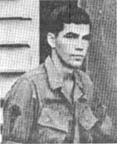 Specialist 4 Gary L. Frankhouse distinguished himself by heroic actions
on December 24, 1968, while serving as a squad leader with Company D, 2d
Battalion, 12th Infantry.
Specialist 4 Gary L. Frankhouse distinguished himself by heroic actions
on December 24, 1968, while serving as a squad leader with Company D, 2d
Battalion, 12th Infantry.
While on a combat operation,
Company D came under a treacherous barrage of Communist automatic weapons and
RPG fire.
Frankhouse, reacting
immediately, dauntlessly exposed himself to the fierce Viet Cong shelling as he
placed lethal suppressive fire on the enemy positions.
Observing
a wounded comrade in severe pain, and in an exposed position, he courageously
moved through the bullet-swept area toward the endangered soldier.
Although seriously wounded
while attempting to reach his comrade, he ignored his injury and continued
through the hail of exploding projectiles to the aid of his colleague.
Upon reaching his fellow
soldier, Frankhouse immediately applied life saving aid, simultaneously placing
blazing M-16 fire on the fanatical aggressors.
With complete disregard for
his personal safety, he remained in an exposed position protecting his injured
comrade until the enemy attack was thwarted.
His valorous actions were
responsible for saving his comrade’s life.
Frankhouse’s personal
bravery, aggressiveness, and devotion to duty are in keeping with the highest
traditions of the military service and reflect great credit upon himself, his
unit, the 25th Infantry Division and the United States Army.
Punch
Cards On R&R Trip
Effective immediately, block
number ‘2’ of the MACV Ration Card (MACV Form 333) will be punched at the
R&R processing center at the time an individual goes on R&R.
Any person who arrives at
the R&R processing center whose card is punched in block number ‘2’ will
be removed from the plane manifest.
The only exception will be
for personnel whose orders indicate they are authorized a second R&R due to
an extension of their foreign service tour for a period of 90 days or more.
R&R orders will be
properly annotated by the issuing authority.
The TROPIC LIGHTNING NEWS is an authorized publication of the 25th Infantry Division. It is published weekly for all division units in the Republic of Vietnam by the Information Office, 25th Infantry Division, APO San Francisco 96225. Army News Features, Army Photo Features, Armed Forces Press Service and Armed Forces News Bureau material are used. Views and opinions expressed are not necessarily those of the Department of the Army. Printed in Tokyo, Japan, by Pacific Stars and Stripes.
MG Ellis W. Williamson . . . . Commanding General
MAJ Andrew J. Sullivan . . . Information Officer
2LT Don A. Eriksson . . . . . . Officer-in-Charge
SP4 Stephen Lochen . . . . . . Editor
SP4 Jim Brayer . . . . . . . . . . . . Assistant Editor
SP4 Robert C. Imler . . . . . . . Production Supervisor
Page 3 TROPIC LIGHTNING NEWS February 3, 1969
 |
MACHINE GUNNER – Specialist 4 James A. Leviscek from Fling, Mich., opens up on a suspected enemy position during a Tropic Lightning sweep near Trung Lap. Leviscek is from the 1st Battalion (Mechanized) 5th infantry. (PHOTO BY PFC RYAN POSTELL) |
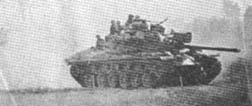 |
DUST BOWL – With a dust trail blocking out the view of the tank’s rear, the mounted infantry-armor soldiers of the 2d Brigade keep an eye out for Charlie. The tank is from the 2d Battalion, 34th Armor. (PHOTO BY SP5 DOUG ELLIOT) | |
| SNOOPY RIDES AGAIN with Tropic Lightning pilots for the command and control ship of the 116th Assault Helicopter Company. The Hornet ship is flying for the 2d Brigade’s 2d Battalion, 14th Infantry. (PHOTO BY 1LT J. N. BLACK) |  |
 |
SEARCH – A Fire Brigade soldier with the 2d Battalion, 27th Infantry Wolfhounds walks along a hedgerow. The rifleman was on a reconnaissance-in-force mission in Hau Nghia Province. (PHOTO BY SP4 BILL CLEVENGER) | |
| UNUSUAL TRAJECTORY? Cannoneers of the 2d Battalion, 77th Artillery blast away during fire mission at Fire Support Base Wood. Captured in the photo is the round from a sister gun just to the right of the one pictured. (PHOTO BY SP5 BILL SLUIS) |  |
 |
| DEPRIVING CHARLIE OF A HOME – Ripping their way through the dense jungle near Dau Tieng, Rome Plows of the 168th Engineer Battalion level the jungles of the Ben Cui rubber plantation, secured by the 1st Battalion (Mechanized) 5th Infantry. Operations like this deprive the Viet Cong of cover for infiltration routes and base camps in the Division’s area of operations. (PHOTO BY SP4 DON MOSSEAU) |
Page 4-5 TROPIC LIGHTNING NEWS February 3, 1969
| ANOTHER SAMPAN is found, adding to the growing list of supplies and munitions uncovered during ‘Big Muddy’. | 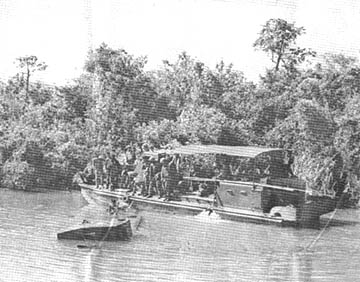 |
|
 |
INFANTRYMEN BECOME WATERBORNE to search an inlet for Viet Cong supply and staging areas. Patrol boats, unable to pass in these shallow inlets, stand by ready to provide suppressive fire if needed. |
Riverine
Forces Meet On The ‘Big Muddy’ Near War Zone C
 Dau Tieng
– Tom Sawyer met Huck Finn on the Big Muddy – but under circumstances quite
different from those related in the classics of Mark Twain.
Dau Tieng
– Tom Sawyer met Huck Finn on the Big Muddy – but under circumstances quite
different from those related in the classics of Mark Twain.
An operation Big Muddy, on
the Saigon River near Dau Tieng, 45 miles northwest of Saigon, turned up enemy
weapons caches and destroyed bunkers and staging areas.
The operation linked
riverine forces of the United States and Vietnamese Navies with Tropic Lightning
infantrymen of the 3rd Brigade.
Conducting the river sweeps
were Huck Finn forces of the Republic of Vietnam’s 28th River
Assault Group and Tom Sawyer river patrol boats (PBRs) of the U.S. Navy’s
River Division 594.
The naval vessels patrolled
the vital tributary almost to the edge of War Zone C as they cut enemy supply
and communication lines leading toward the Saigon area.
Riding the patrol boats of
both forces were Wolfhounds of the 1st Battalion, 27th
Infantry and Vietnamese National Police. They
frequently went ashore to search out suspected enemy positions flanking the
waterway.
During the first days of the
operation the Wolfhounds unearthed more than 24,000 rounds of 7.62 rifle
ammunition, 69 rounds of 60mm and 82mm mortars, 1,100 rounds of .51 caliber
machinegun ammo and 500 rifle grenades in caches near the riverbanks.
Tactically, the Tropic
Lightning brigade’s first large-scale riverine operation was a big success.
Not only was the enemy denied the use of one of his favorite supply
lines, but he will have a lot of digging to do if he hopes to relocate his base
camps and staging areas along the Saigon River.
ARMED PATROL
BOATS,
minesweepers, and troop carriers (above right) from the Vietnamese Navy’s 28th
River Assault Group transport soldiers of the 1st Battalion, 27th
Infantry Wolfhounds up the Saigon River during the operation nicknamed ‘Big
Muddy’.
|
Story
And Photos |
| CAUTIONSLY CHECKING for possible booby traps, SP4 Clifford L. Green of St. Marys, Pa., probes under the lid of a Viet Cong ammunition box. | 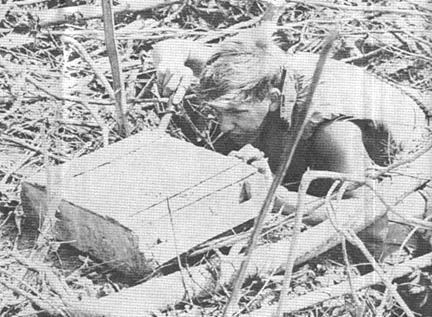 |
 |
A LAST MINUTE communications check is made before moving to conduct sweeps along the Saigon River. |
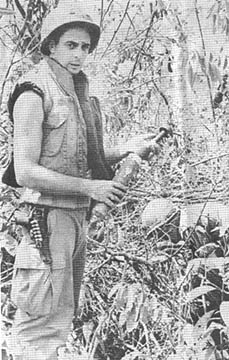 |
|
Page 6 TROPIC LIGHTNING NEWS February 3, 1969
Fire
Brigade Throws Festival For Two Vietnamese Hamlets
CU
CHI -
In extending the efforts to pacify the once VC controlled hamlets of Thai My and
Bau Dieu, Division units recently conducted a district festival for Vietnamese
Civilians in that area.
Sponsored by the 2d Brigade
Civic Action Office, the festival provided food, gifts, and entertainment for
some 1500 Vietnamese who attended.
Joint MEDCAPs by 2d Brigade
units, the Division Support Command and Division Artillery treated nearly 600
patients and provided soap, health information, literature and other sundries
for those present.
Gifts for the 600 children
present included T-shirts, shorts soccer balls, kites, shoes, candy and
Vietnamese Flags. For the adults there were sewing kits, clothing, food, cooking
oils, newspapers and cigarettes.
A part of the intended
result was to meet the people and establish a common ground of understanding,
and to foster in the people a desire to help build a united Vietnam.
“The people have a natural
fear of the unknown,” said Colonel Eugene M. Lynch, Fire Brigade commander.
“We have two unknowns here. The
people don’t know the government and the government doesn’t know the people.
Therefore they seem to have had a fear of each other.
“It’s when we get the
two unknowns together like this and overcome the fears that we begin to make
progress. Our concern here is
nation-building,” he continued, “but the people have to want to help. The
festival helped to get them together, and I think it came off very well.”
Major Calvin Swinson,
brigade civic action officer said, “We hoped to show the people that the
government of Vietnam is supporting them and that their hamlets are now secure.
I think we were very successful in that the people were able to come
together, which they are rarely able to do.
They were all there from the District Chief, Village Chief on down.”
 |
SECOND BRIGADE COMMANDER Colonel Eugene M. Lynch enlists the aid of ARVN Captain Nguyen Ding Dao, Fire Brigade liaison officer, to chat with a young student from the Phuoc Hiop school at the recent district festival near Bau Dieu. (PHOTO BY SP4 FRANK HEINY) |
Tay
Ninh MEDCAP Treats Over 2,000
By 1LT Mack D.
Gooding
TAY
NINH
- One of the largest MEDCAPs (Medical Civic Action Programs) ever held in South
Vietnam was conducted by the 1st Brigade at Tay Ninh base camp.
It treated 2,448 patients.
The MEDCAP consisted of
giving plague inoculations to Vietnamese who work at the 1st Brigade base camp.
As each laborer reported for work he was greeted by medics of Delta
Company, 25th Medical Battalion, and 1st Brigade
civic action personnel. Each
laborer, to include National Policemen and interpreters, was given a
plague shot and a shot record. Treating
approximately 600 patients per hour, the giant MEDCAP was completed in four in
short hours.
The mass inoculation MEDCAP
was part of a Vietnamese program to inoculate all Vietnamese by mid-January 1969
as decreed by the Vietnamese Minister of Health.
“Today’s effort was just
the beginning,” stated Major Clarence M. DeYoung of San Diego, Calif., civil
affairs officer for the brigade. “We
will immunize during all future MEDCAPs, in an effort to help the provinces
reach their target date,” he continued.
Tay Ninh officials have
inoculated 11 per cent (40,000) of the province’s 387,000 inhabitants,
exclusive of the 1st Brigade. Four
province health teams will be combined with future brigade MEDCAP teams giving
the teams the potential of inoculating 15,000 to 25,000 per day.
The inoculation of the
Vietnamese labor force has other ramifications according to DeYoung.
“Besides the obvious effects, the inoculations show our interest in the
people. It also shows them how to
improve their own health standards.”
Vaccine for the MEDCAP was
provided by the Tay Ninh Province Hospital.
Mass inoculation against cholera and small pox will be undertaken in the
future as the vaccine becomes available.
Singing
GI Goes To Dogs
TAY
NINH
- GIs who like to find a quiet corner to strum a guitar and sing have enough
trouble eluding the ever-present sounds of AFVN radio, and now the dogs may be
turning against them too.
Sergeant Larry W. Jennings,
Dallas, Tex., a mail clerk with the 4th Battalion, 9th Infantry, was in a hootch
at Tay Ninh base camp one night recently playing and singing “Once A Day”
when he was suddenly - without
invitation - joined by a passing mongrel who howled along in tempo.
Unflustered, Jennings called
out, “What are you, a music critic? I don’t criticize your barking, do I?”
With that the dog stopped
his accompaniment, lifted his nose in the air just slightly, and trotted off.
|
READY TO GO - Fire Brigade Soldiers from the 2d Battalion, 27th Infantry Wolfhounds hurry into position to catch the next lift during eagle flight operations near Cu Chi. (PHOTO BY SP4 BILL CLEVENGER)
|
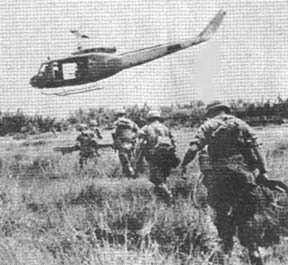 |
Safety
Signs For Highway
CU
CHI -
Highway 8A, which for some time has carried enough traffic to be considered a
huge international thoroughfare, now has the road signs it deserves.
Second Brigade soldiers from the 2d Battalion, 34th Armor, have seen to
that.
Sergeant First Class Billie
P. Brown of Campbellsville, Ky., originator of the idea, gathered together scrap
metal and, with the help of Specialists 4 Arthur Hale of Anchorage, Alaska, and
Kenneth Hall of Frederick, Md. cut
and built the yellow and black, triangular signs. Lieutenant Colonel Theodore E. O’Connor of College Point,
Tex., Dreadnaught commander, supported the effort.
Upon completion of the signs, the 5th ARVN Regiment’s civic
action personnel helped place the signs at school sites along the bustling 8A.
What’s next?
The Tropic Lightning soldiers and ARVN personnel are now preparing speed
and other highway signs for the heavily populated areas along 8 Alpha.
Page 7 TROPIC LIGHTNING NEWS February 3, 1969
Many
Masters For Support Platoon
TAY
NINH -
Rarely honored but always appreciated is the Support Platoon of the 3d
Battalion, 22d Infantry.
Led by First Lieutenant
Joseph J. Mattoni of Toledo, Ohio, the unit is responsible for resupplying the
entire battalion which is scattered over three fire support bases, a defensive
perimeter on Nui Ba Den mountain and Tay Ninh base camp.
The platoon has only two
NCOs and 12 enlisted men, and has its hands full meeting tight schedules and
stringent resupply requirements.
Warrant Officer James E.
Ross of Elizabethtown, Ky., has the tough job of maintaining the nine 2 1/2 ton
trucks, five water trailers, one jeep and other equipment ranging from huge
power generators to small buzz saws.
“We are constantly plagued
with mechanical failures,” he maintains.
“The roads we have to cover are extremely hard on vehicles.
Our trucks aren’t exactly the newest in the world, but we’ve found
that steady preventive maintenance has paid off with fewer mechanical
failures.”
Ross and his crew work as
long as necessary to keep all of the equipment in top operational order.
Their normal working day comprises 16 hours of tough delivery and repair.
Not only does the equipment
have to be kept in top working order, it also must be clean. Along with the dry season has come the dust.
To keep the dust down, Penaprime (a tar-like substance) is spread in
dusty areas.
The billowing dust creates
an enormous safety problem. Chopper
pilots cannot see through the swirling dirt.
Specialist 4 Charles North
of Nu Mine, Pa., commented, “Sure it’s a messy job and cleaning the trucks
afterward is quite a job. A lot of
the tasks we have to perform are not pleasant, but they have to be done.”
Support also maintains its
own parts shop. Stocking parts for
everything from machine guns to large trucks, the platoon is responsible for
providing weapons parts as need arises for them in the forward locations.
When lead is unloaded on
Charlie, Support picks up ammunition from its own ammo dump and whisks it out to
where it is needed.
Recently the platoon has
completed a grease rack to give faster and easier lubrication to and repair of
vehicles. Every other week each
vehicle is given an oil change and a grease job.
Batteries are checked on a
daily basis and recharged as necessary. Because
of the extremely dusty conditions air and oil filters must be changed frequently
to protect the inner working parts.
Establishing fire support
bases has been a major task for Support. Recently
they were called upon to aid the Regulars’ D Company in building a fire
support base south of Tay Ninh and at the same time relocate a fire support base
occupied by C Company located north of Tay Ninh.
Dividing their assets,
Support moved out before daybreak and remained on location until after sunset
when the job was completed. Twenty
truckloads were required to set up Delta’s location while C Company used over
thirty loads to move their base camp which had been originally set up to be
occupied by two companies.
Fighting mines, ambushes,
sniper fire and flat tires, the trucks moved out to the fire support base with
only one man riding as shotgun for security.
Frequently the roads traveled have not been swept for mines but the trips
must be made to deliver the urgently needed supplies.
Private First Class Joseph
C. Phillips of Costa Mesa, Callf., claims, “The best way to avoid ambush is to
drive as fast as possible, but unfortunately the condition of the roads does not
permit this. Because of the holes,
our speed is cut to a mere crawl.” They
may have to move slowly but they always get there on time.
Support has been absolutely
necessary in the past and continues to set higher standards for itself daily.
During the August-September Battle of Tay Ninh, the platoon was
responsible for moving over 73 tons of ammunition in three days.
Working around the clock, they prepared the delicate cargo into slings to
be lifted out by Chinooks.
Because of the exceptional
work of this small unit, the Tropic Lightning troops it serves can count on
having their rations, munitions and equipment for their fortifications as
quickly as the need arises.
 |
CRANK HER UP – Ready to start a chain saw they have just repaired are Warrant Officer James E. Ross of Elizabethtown, Ky., and Specialist 4 David H. Munce, right, Columbus, Ohio. Ross is in charge of all repair work done for the Regulars. |
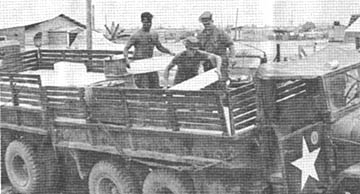 |
| A COOL JOB - Dividing up ice to be taken out to two fire support bases are (from left), Specialist 5 Paul H Kupperman of New York City, Specialist 4 Dennis R. Bolton of Auborn Heights, Mich., and Private First Class Bill Graham of Grand Lodge, Mich. Each is in the Support Platoon of the 3d Battalion, 22d Infantry. |
Logic
Dictates ‘No Can Do’, But Engineers Rebuild Bridge
By 2Lt Larry M. Nichols
CU
CHI -
Construction engineers said it couldn’t be done - not short of full
restoration - but the 65th Engineer’s Echo Company has repaired the Go Dau Ha
Bridge.
The Echo Engineers used a
144-foot double-triple Bailey Bridge capable of carrying division-load vehicles.
The middle span of the
500-foot existing concrete bridge was blown by the Communists on March 29, 1968.
The bridge is the only span across the Oriental River in Vietnam and the
major link on National Highway 2 between Saigon and the Cambodian border.
Opening ceremonies were held
with Major General Ellis W. Williamson, division commander, and Colonel Nguyen
Quang Thong, Tay Ninh province chief, giving keynote addresses.
Plans for the construction
of the Bailey were begun in early November and considered to be of such
importance that Captain Michael Foster, Echo Company commander, extended his
tour by 20 days in order to complete the project.
Repair of the bridge was an
engineering feat rarely attempted by combat engineers in a war zone, according
to Major John Pearson, former Assistant division engineer for the 65th and
project engineer.
“The erection of the
bridge for this particular span was unique,” Pearson said,
“in that the span had to be built at half its normal width and then
shoved across the gap before it could be widened to its full 16 feet.”
Bailey bridges are normally
16 feet wide and erected completely on the near shore of the gap.
Once they are shoved across the gap, treadway and other finishing work
such as approaches are completed.
The Go Dau Ha Bridge was
erected in skeleton form on the near shore, and then pushed across the gap.
Once the bridge was set, the half-sized transoms were removed and lowered
to a barge 50 feet below.
After this part was
completed, the bridge trusses were spread to normal width, full-sized transoms
were emplaced and the remaining three stories of panels, chess and decking put
in place.
“So far, as we have been
able to tell,” Pearson said, “a Bailey erection of this type has never been
attempted before.”
Before construction on the
Bailey could be started, fifth Engineers were faced with the problem of
constructing a far shore bent that would hold the load of the 130 ton completed
bridge plus its anticipated division load traffic.
“It’s the kind of job
that normally would be given to a port construction engineer company,” Foster
said, “but all we had was one platoon plus whomever we could borrow from the
heavy equipment platoon of Headquarters Company.
It was enough, though, and three days after we started, we had our bent
waiting for our bridge.”
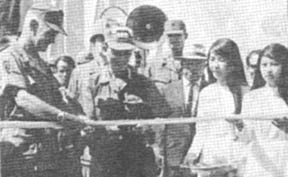 |
BRIDGE OPENING - Major General E. W. Williamson, commending general of Tropic Lightning (right), and Colonel Nguyen Quang Thong, Tay Ninh province chief, cut the ribbon to officially open the newly repaired Go Dau Ha bridge. | |
| THE TWAIN WILL MEET - The nose of the 144-foot skeleton Bailey Bridge reaches out across the Oriental River. The 65th Engineer Battalion made repairs on the bridge. Picturesque Nui Ba Den mountain is in the background. (PHOTOS BY 2LT LARRY M. NICHOLS) |  |
|
Story, Photos By SP4 Dave DeMauro |
Page 8 TROPIC LIGHTNING NEWS February 3, 1969
 |
A PRESENT FOR CHARLIE - A gun section from A Battery, 7th Battalion, 11th Artillery, is shown in action as a cannoneer chambers one of the 1,500 105mm howitzer rounds fired in a three-hour period during a fire mission at Fire Support Base Washington, five miles north of Tay Ninh. A Battery was firing in support of the 3d Battalion, 22d Infantry who had become engaged in heavy contact. |
Arty
Piles It On For Regulars
TAY
NINH
- An urgent request for artillery support was answered with 1,500 105mm howitzer
rounds in a three-hour period by A Battery, 7th Battalion, 11th Field Artillery.
Battery A, located at Fire
Support Base Washington, five miles south of Tay Ninh Base Camp, was firing in
support of the 3d Battalion, 22d Infantry.
As the Infantry’s direct support artillery, the unit was responsible
for providing the major share of artillery fire in support of this operation.
Within seconds after the
Infantry became engaged in combat, a high volume of fire was delivered in close
proximity to the maneuver units in “danger close” missions.
The battery continued firing
all night long, and by morning a total of over 2,500 rounds had been fired
within a 17-hour period in support of the operations. It was called a “superb
performance” by Lieutenant Colonel Walter A. Wood III, 7th Battalion, 11th
Field Artillery Commander.
In addition, A Battery was
joined by four 105mm howitzers from B Battery, 7th Battalion, 11th Field
Artillery, the following morning. B
Battery set up their guns in a laager adjacent to Fire Support Base Washington
to provide additional fire power.
That morning the two batteries fired over 500 rounds in a
15-minute prep mission, firing preparation rounds for an air combat assault
operation. Major General Ellis W.
Williamson, division commander, commented about the operation, “This is the
finest preparation I have witnessed in Vietnam.”
‘Quack’
Outfit Arrives At Go Dau Ha Bridge
By SGT Herb Burdett
TAY
NINH
- When First Lieutenant Lesley Witmer of Leola, Pa., thinks about those he has
commanded, his thoughts naturally wander to a squad of ‘Quack’ troops that
waddle and honk a lot.
Witmer is a member of the
1st Brigade Impact Team charged with expediting the delivery of eight garrulous
geese to the Go Dau Ha Bridge where they will act as anti-intrusion devices for
the Tropic Lightning troops.
“When I was serving with
the 2d Battalion, 12th Infantry on the Hoc Mon Bridge we used a pair of geese as
an early warning system, and they sure kicked up a fuss when anyone came near
them,” said Witmer.
“We placed them next to an
avenue of approach that was hard to observe.
Sure enough, as soon as some one came within 50 or 75 meters of their pen
they started squawking,” continued Witmer.
“We tested and retested the geese and they worked every time.”
“Our new squad of honkers
will provide the answer to a rather sticky problem at Go Dau Ha,” said Witmer.
“One of the approaches to the bridge is hard to scan and is extremely
wet and marshy, making it impossible to build a bunker out there.
Placing the geese in a pen at this location will provide just the warning
system we need.”
Other units in the Division
have had much success using geese as warning systems.
Company B of the 3d Battalion, 22d Infantry, used a cantankerous bird
named Phu Cong when they were stationed on the Phu Cuong Bridge.
“Our goose could honk with the best of them and did so whenever anyone
approached,” said Captain George Featherston of Houston, Bravo Company
Commander. “We became so attached
to the animal that we took him with us to Fire Support Buell and then up to Nui
Ba Den Mountain’,” continued Featherston.
“He just loved scrambled eggs and was authorized to go through the chow
line, but we had to keep an eye on him, or he would go back for seconds.”
Manchus
Answer Call For Scubas
TAY NINH - Although anyone
who has slogged through rice paddies during the rainy season might dispute the
point, infantrymen are not usually expected to be scuba divers.
But when Tropic
Lightning’s 1st Brigade headquarters at Tay Ninh flashed a “help wanted”
call for divers to help retrieve a helicopter that had crashed in a nearby
river, two volunteers from the 4th Battalion, 9th Infantry Manchus were ready to
respond.
Both First Lieutenant Harry
D. Barnes, Orlando, Fla., the battalion artillery liaison officer, and
Specialist 4 Mike Hellman, Kiowa, Kan., a Bravo Company medic, were helilifted
to the crash site from the Manchus’ Mole City patrol base 16 miles southeast
of Tay Ninh. Both Barnes, who has
dived off Bermuda and Florida, and Hellman, who has gone underwater sightseeing
off California beaches, were ready.
But the diving equipment
they needed to go into the 40-foot deep river didn’t arrive until two hours
later, and when it came it was
accompanied by divers from the 65th Engineers Group, who retrieved the crashed
chopper.
The Manchus were ready and
willing to go waterborne, but this time they weren’t needed.
 Wells
Yield 3 Chicom Mines
Wells
Yield 3 Chicom Mines
CU CHI
- Antitank mines are often costly traps for armored giants.
The mines were found in shallow wells along Highway 8A, halfway between
Cu Chi and the Phu Cuong Bridge.
The combined sweep consisted
of members of the 2d Battalion, 34th Armor’s scout platoon and an element of
the 7th ARVN Regiment. The units were under control of Major Benjamin B. Beasley
of Gainesville, Fla.
Specialist 4 Delbert C.
Jackson of Martinsville, Va., the major’s driver started things off when he
strolled over to one of the many wells in the area and looked down at a metal
object.
Searching the area, the
Tropic Lightning soldier found two other mines in nearby wells. Also
found were two artillery rounds.
HAPPY
FIND - Specialist 4 Delbert Jackson, Martinsville,
Va., a 2d Brigade soldier kneels beside the anti-tank mines he discovered on a
recent sweep led by 2d Battalion, 34th Armor.
(PHOTO
BY SP4 DOUG EILIOT)
2-22
Repairs Kids School
DAU
TIENG
- The enlisted men of the 3d Brigade’s Triple Deuce are working hard to
rebuild schools that the Viet Cong are going to great pains to tear down.
“The project is to repair
and rebuild schools in this area that the VC destroy, and give the kids a better
place to be educated,” summarized First Sergeant Alfred J. Macias, of
Hattiesburg, Miss., a member of the board of governors.
Not knowing the best site to
institute the program, SGM Robert L. Goltz, of Loveland, Colo., asked the
battalion civil affairs officer First Lieutenant P. Devereaux, of Chicago, to
select a needy site.
“I know just the place,”
explained Devereaux, ”the small school of Ben Cui II was heavily damaged
during a VC mortar attack, and was the perfect place to start our program.”
“The necessary roofing
tile, lumber, and cement will be purchased by us on the local market, and the
labor will be provided from the local resources,” said Devereaux. “This way we rebuild the school, and help the local economy
at the same time,” he noted.
The people of the area were
quick to recognize the good intentions of the men of the 2d Battalion (Mech),
22d Infantry. As work began on the
school, several requests for English classes were received.
Thanks to
Mack D. Gooding, 15th PID, 1st Bde., for sharing this issue,
Kirk Ramsey, 2nd Bn., 14th Inf. for creating this page.
This page last modified 8-12-2004
©2004 25th Infantry Division Association. All rights reserved.